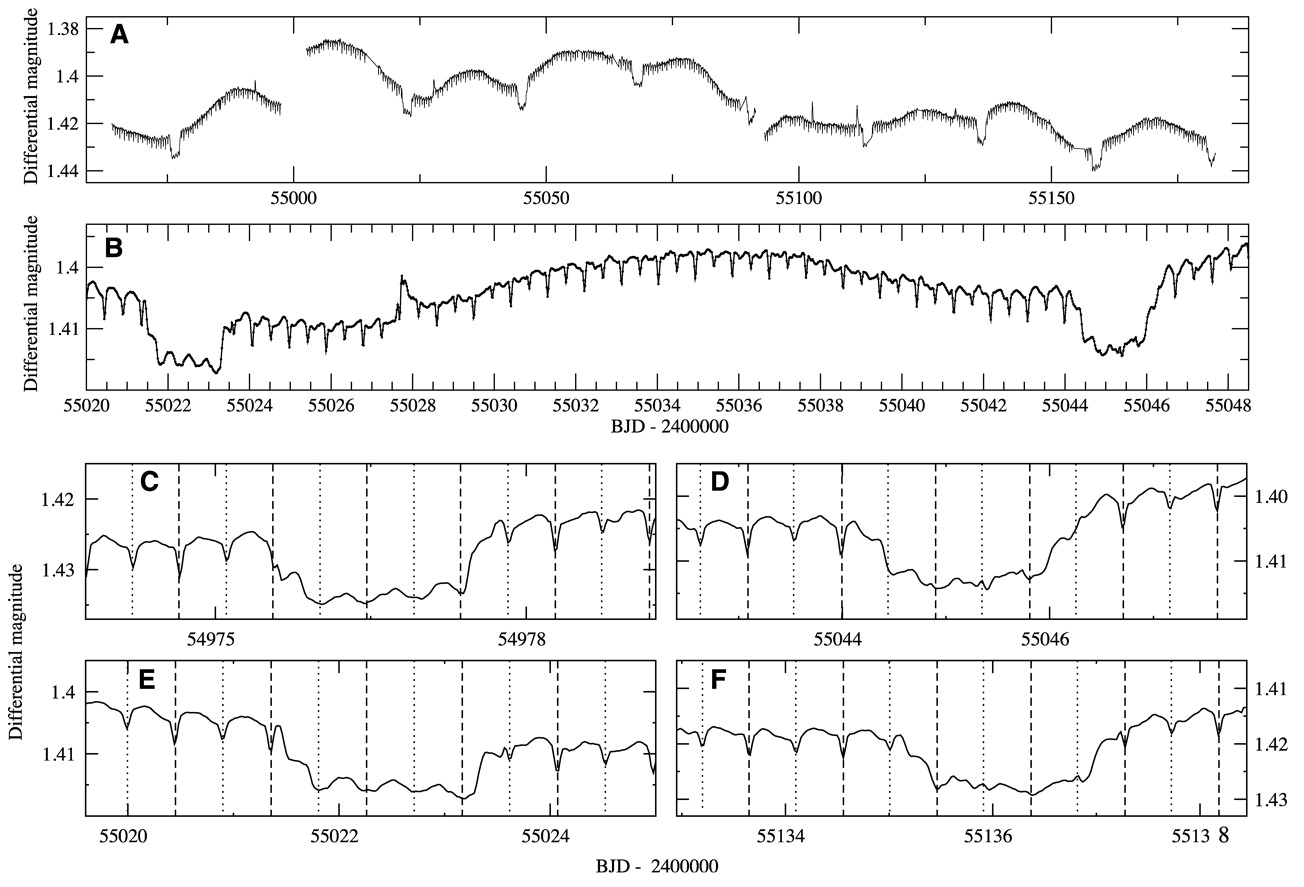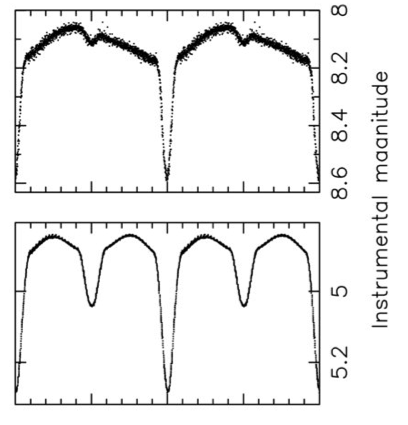|
|
|
||

| |||
| Kepler Astrophysics Data Showcase | |||

|
|
Ensemble Asteroseismology of Solar-Type Stars with the NASA Kepler Mission An international team led by asteroseismologists from University of Birmingham have announced the discovery of stars similar to our Sun. Using Kepler data, they found 500 stars with solar-like oscillations in the Kepler field of view. With the study of these oscillations, astronomers can probe the interiors of stars and constrain stellar models to determine global properties. The detection of these oscillations was made possible by the high precision photometry Kepler. |
|

|
|
Gravity modes as a way to distinguish between hydrogen- and helium-burning red giant stars A team led by astrophysicists at the University of Sydney, Australia, have discovered a way to distinguish red giant stars by their fuel burning energy source. For their study, 400 red giants stars were observed by Kepler. Using asteroseismology, they analyzed the frequency spectra of the red giants and identified specific frequencies associated with different stellar energy generation properties. They were able to distinguish a red giant who is burning hydrogen or helium in the core, or if hydrogen is burning in a shell around the core. Because the fuel being used by the star to sustain itself is also a marker for what evolutionary state it is in its lifetime, and hence a measure of the age, this is a valuable result for stellar population studies and stellar modeling. |
|

|
|
HD 181068: A Red Giant in a Triply Eclipsing Compact Hierarchical Triple System HD 181068, a 7.1 magnitude star, was observed by Kepler for 218 days, and the data revealed a hierarchical triple eclipsing system. Coupled with ground-based spectroscopic and interferometric data, stellar parameters such as mass were determined. This system is composed of a primary red giant star orbiting with a period of 45 days around a red dwarf pair, which itself is orbiting with a 0.9 day period. Such stars can test theories of multiple star formation and orbital dynamics. |
|

|
|
KOI-54: The
Kepler Discovery of Tidally-Excited Pulsations and Brightenings in a
Highly Eccentric Binary This oscillating Algol-type semi-detached binary star (oEA) is a serendipitous discovery. The stars are in a highly eccentric orbit (e=0.83), and during periastron, a brightening event is observed. This event is the result of tidal interaction and irradiation of the A stars in this system. During this close approach, the gravitational interaction between the stars also induces pulsations. KOI-54 is one of four known stars displaying this phenomenon. |
|

|
|
LHS 6343 C: A Transiting Field Brown Dwarf Discovered by the Kepler Mission
Kepler time series data has uncovered a brown dwarf transiting one component of a low-mass binary system, consisting of two M dwarfs. The M dwarfs have masses = 0.37 and 0.30 M☉; precision radial velocity measurements give a mass for the transiting brown dwarf = 62.7 MJup. Only a handful of transiting brown dwarfs are known at this time. Follow-up observations of this system will provide a number of opportunities to measure detailed properties of this brown dwarf. Phased light curves from Kepler and the Nickel 1-m telescope (Lick Observatory) overlain with a best-fit model are shown at left. |
|

|
|
Kepler
Eclipsing Binary Stars. This catalog identifies 1879 binary stars from the first 44 days of Kepler operation. The incidence of eclipsing systems is 1.2%, which is a higher rate than the occurrence rate from the Hipparcos survey (0.8%). The Kepler data of these eclipsing binary systems provides a resource for stellar populations studies, investigations of stellar parameters, and theoretical modeling. |
|

|
|
Kepler observations of the beaming binary KPD 1946+4340 This eclipsing binary system is comprised of a post extreme horizontal branch subdwarf B star (0.47 +\- 0.03 M) and a carbon-oxygen white dwarf (0.59 +\- 0.02 M). Kepler short cadence data reveals multiple effects: primary and secondary eclipses, ellipsoidal modulation, Doppler beaming, and gravitational lensing effects. Markov Chain Monte Carlo simulations provided derivations of stellar parameters such as mass, radii, and effective temperature. |
|

|
|
Flavors of variability: 29 RR Lyrae stars observed with Kepler Photometric details in Kepler data provide an unprecedented look at pulsational modes in a variety of variable stars. For 29 RR Lyrae variable stars, long-cadence time series data from Q1 and Q2 were analyzed. Many of the RR Lyrae stars pulsating in the fundamental mode appeared to exhibit the amplitude modulation phenomenon, known as the Blazhko Effect. The time series also provided the discovery of new frequencies, as well as new modulation effects in amplitude and phase. The standout RR Lyrae variable star in this sample was V350 Lyr, which was found to be the first double-mode RR Lyrae pulsator with simultaneous fundamental and second overtone modes. |
|

|
|
Does Kepler unveil the mystery of the Blazhko Effect? The phenomenon of "period doubling" has been discovered in RR Lyrae variable stars with the Blazhko Effect after a careful analysis of Kepler long-cadence data. Three stars, RR Lyr, V808 Cyg, and V355 Lyr, all show evidence of this transient effect along with the dominant Blazhko Effect. Period doubling is seen as alternating maxima and minima of the light curve. A Fourier spectrum of these stars also show half-integer frequencies. This new effect is believed to be coupled with the Blazhko Effect, and its discovery is only possible through the unique capabilities of Kepler with its time-series cadence and continuous monitoring. This new discovery will help constrain hydrodynamical models of these helium-burning stars. |
|

|
|
Hybrid Gamma Doradus -
Delta Scuti pulsators: The study of γ Doradus and δ Scuti stars with Kepler presents a curious new discovery - almost none of the candidate stars observed are pure γ Doradus or δ Scuti variable star types. These stars appear to be a hybrid of the two classifications showing frequencies of both types of stars. Originally, γ Doradus stars are pulsators with a 0.3 to 3 day period range with g-modes, and δ Scuti stars have periods between 0.014 and 0.333 days and pulsate with predominantly p-modes. With the high quality photometry from Kepler, these stars can be used to investigate the hybrid nature of these variable stars, and their possible connection with chemically peculiar Am stars. The discovery of new modes will help constrain models of the pulsation mechanism. |
|

|
|
Quiescent
Superhumps Detected in the Dwarf Nova V344 Lyrae by Kepler V344 Lyr is a cataclysmic variable of the SU UMa class. The Kepler short cadence (1-min) data reveals the well-known spectacular outbursts from this object occurring on a quasi-regular 10 day timescale. These are the result of a continuous pileup of accreting material in the outer accretion disk, surrounding a parent white dwarf, triggering a state change and a rapid infall of gas towards the center. The quiescent magnitude of this target is Kp = 19, yet Kepler detects and resolves fantastic detail and evolution of the target as it is dominated by both the orbital period of the binary and precession period of the outer accretion disk at different times during the quarter. |
|
Questions concerning Kepler's science opportunities and open programs, public archive or community tools? Contact us via the email address.